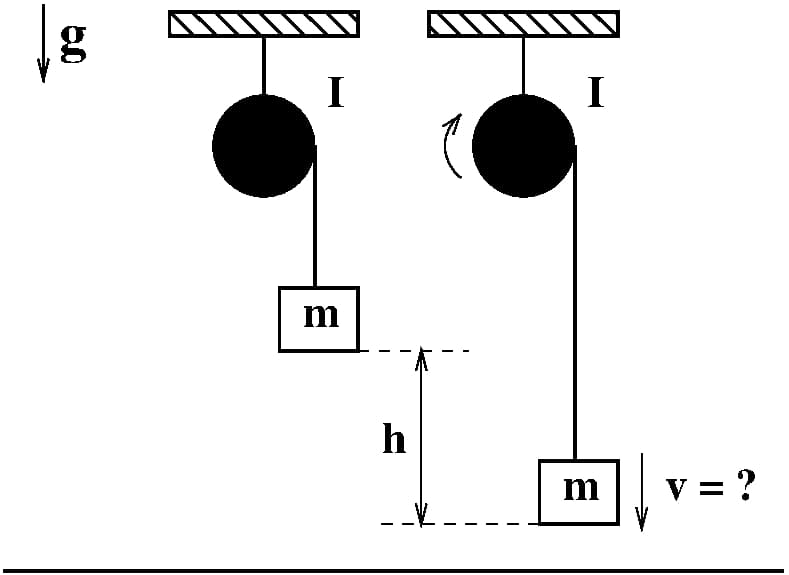A box of mass m = 0.7 kg is attached to a rope which is wrapped around a physical pulley with a radius of R = 10.2 cm and a rotational inertia of I = 0.075 kg·m2. When the box is released it starts to fall down with a constant acceleration and, at the same time, the pulley starts to spin up, see the picture below. Assuming that the pulley is frictionless, what is the magnitude of the
A box of mass m = 0.7 kg is attached to a rope which is wrapped around a physical pulley with a radius of R = 10.2 cm and a rotational inertia of I = 0.075 kg·m2. When the box is released it starts to fall down with a constant acceleration and, at the same time, the pulley starts to spin up, see the picture below. Assuming that the pulley is frictionless, what is the magnitude of the box's acceleration and what is the tension in the rope?
The acceleration of the box, a ?
The tension in the rope, T?
If the box starts from rest and traveled downwards a distance of h = 28 cm, what is the speed of the box and what is the angular velocity of the pulley?
The speed of the box, v =?
The angular velocity of the pulley, ω?
--------------------------------------------------------------
A Merry Go Round carousel has a radius of R = 2.4 m and a rotational inertia of I = 695 kg·m2. A 75‑kg student is on the carousel at the midpoint between the carousel's center and the rim (at R/2 distance from the center). Initially the system rotates about a vertical axis that goes through the center of the carousel at 2 rad/sec.
If the student walks to the rim of the carousel, the system will _______________. What is the new angular velocity of the system in this case?
The new angular velocity, ω1 ?
If the student walks to the very center of the carousel, the system will ___________________. What will be the new angular velocity of the system?
The new angular velocity, ω2?
If the student started from the midpoint, how much work should be done by him in order to reach the center of the carousel?
The work done by the student, W ?
-----------------------------------------------------------------------------------
When a star collapses it significantly shrinks in size and spins up. Consider a star with a mass of M = 2.2×1030 kg and an initial radius of Ri = 6.6×106 km. If the initial period of rotation of the star is Ti = 35 days, find the new rotational period after it collapses to a final radius of Rf = 6.6×103 km. Treat the star before and after the collapse as a solid sphere with uniform mass distribution (which is not true, of course, but good enough for an estimation).
The new rotational period of the star, Tf ?
Find the ratio between the final and initial rotational kinetic energies of the star.
The factor by which the kinetic energy of the star increases, KEf/KEi ?
The increase in the rotational kinetic energy of the star comes from gravity. How much work is done by the gravity force while collapsing the star?
The work done by gravity, W

Trending now
This is a popular solution!
Step by step
Solved in 2 steps with 2 images


